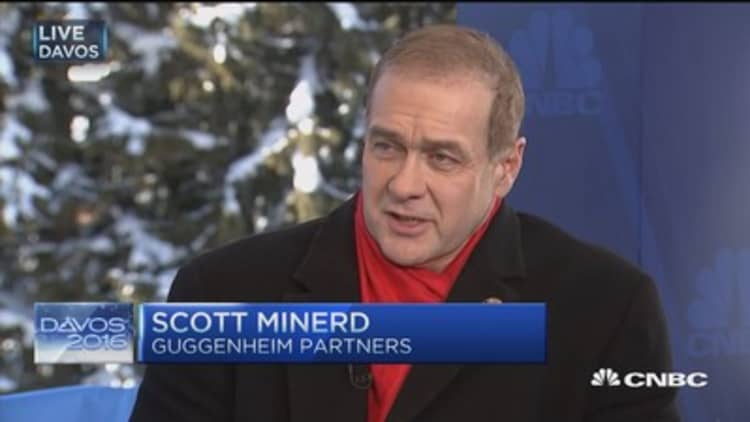The stock market may be taking a breather from its big fall — the was up about 2 percent on Jan. 22 — but one economist thinks that we're going to see plenty more volatility in the next few months and another big correction in about two years.
Alan Beaulieu, economist and co-principal of ITR Economics, a New Hampshire-based economics consultancy firm, thinks that macroeconomic fears will make investors jittery for some time, at least until China's government intervenes with a stimulus program.
Looking further into the future, we'll see another decline, of at least 10 percent, in late 2018, when U.S. interest rates reach 3.5 percent, he said. That will make it more difficult for the consumer to continue propping up the economy with spending.
Beaulieu, who runs the firm with his twin brother Brian, also an economist, has a history of getting calls right. He predicted the current drop back in 2009. He also called the recession, and according to him, their predictions have come true 95 percent of the time over the last 60 years.
The Beaulieus use a proprietary mathematical equation called cycle theory, but a big part of their work focuses on the rate of change in leading indicators — or how fast indicators change from one month or one year to the next.
Most of its predictions are short term — a year out — but it does make much longer calls, too. Its firm has given advice to major companies, such as Honda, Caterpillar, J.P. Morgan, Wells Fargo and more.

"We thought there were would be a correction for two reasons," said Beaulieu. America's unprecedented quantitative-easing program would buoy the market, and it would take time before China's rapid growth came to a halt.
He believed that quantitative easing would end up driving inflation much higher, which would then sink the markets, but that part hasn't yet happened. "Money never really flowed through to the mainstream," he said in an interview this week. "Corporate holdings of cash have ballooned dramatically."
His thoughts on China, though, have come true. In 2009 he and his brother predicted that wage inflation would occur, costs to clean up the environment would increase, rising incomes would hurt its ability to manufacture goods cheaply, there would be blowback around intellectual property theft, and all of this would cause China's growth to slow down. In turn, they'd use less commodities, and that would impact oil and metal prices and everything in between.
Beaulieu also said that the shift from an export-led economy to a more domestic-led one — something China has been working on for years — has failed. "That grand decision has not worked out," he said. "The middle-class growth hasn't been able to sustain the economy." It's this slowdown that's been a major factor in the recent correction, he explained.
Half a year of volatility
While he doesn't think we'll experience a more than 20 percent market drop like we did in 2008 — America is in a much better position than it was back then, he said — we will likely see some more large swings and increased volatility until at least the middle of the year. Why only until the middle of the year? Because market ups and downs are usually related to people's fears, and those worries won't dissipate for a few months.
Investors are nervous about where the global economy is headed, and the cycle of mass sell-offs discount buying and then selling again will continue until people start feeling more comfortable, he said. It will take two things for people to feel calmer. They need to see America's economy growing — and it is, Beaulieu said — and an intervention in China.
"The U.S. is leading the way, economically speaking," he said. "The American consumer is doing yeoman's work. It's marvelous. We have low debt, low delinquencies, good savings in terms of dollars, and spending is at high levels. There's job creation, and the economy is strong."
China will recover in 2016 and will see its GDP grow by 6.5 percent, he said. In the next quarter, the government will announce that it will spend billions on infrastructure, much like it did during the crisis. Programs likely won't get implemented until mid-year, which is when people will start to calm down.
"That will be enough to put the world into a better place in the second half of 2016," Beaulieu said.
More pain in 2018
Things will remain calm for about two years, except for another decline of at least 10 percent in the latter half of 2018 or early 2019, he said, thanks to rising U.S. interest rates.
The Federal Open Market Committee has said that it expects rates to rise to around 3.5 percent in 2018, which would put 30-year fixed mortgage rates at about 6.5 percent to 7 percent, while credit card variable rates would rise by about 3 percentage points, he said. While this is historically normal, it would be high for the majority of people who haven't ever had to deal with rates at that level.
Until then, job growth and consumer activity will do well, he said, but once consumers can't fuel the economy anymore, we'll start seeing layoffs, corporate profits declines and modest inflation. Then the stock market will suffer.
"[Rates] can be expected to have a negative impact on discretionary income and thus have a negative impact on home purchases and consumer spending," Beaulieu said.
With all of this in mind, he thinks investors should pick the spots that will benefit from spending. Beaulieu suggests owning stocks that will benefit from good consumer activity and mild inflationary pressures, such as companies in the consumer staples, discretionary and real estate sectors. Commodities, like oil and gas, also tend to be more profitable in inflationary environments, he said.
By the end of 2018, though, and definitely into 2019, investors should get much more conservative in their portfolio. Own one of the more defensive stocks, such as utilities or staples, or companies that pay a dividend above or in line with the rate of inflation, he said. Bonds, unless they're held to maturity, are a risk as their prices fall when rates rise, he added.
Knowing that his predictions tend to come true, Beaulieu made sure that his own portfolio was set up to withstand any market shocks.
He won't say how much money he moved out of equities, but he did put stops on some of his stocks last year so if they fell too far, they'd sell automatically. Beaulieu also bought real estate in order to own some uncorrelated assets.
"We wanted to reduce the downside pressure on the stock market," he said. "So we put on the breaks."
— By Bryan Borzykowski, special to CNBC.com





